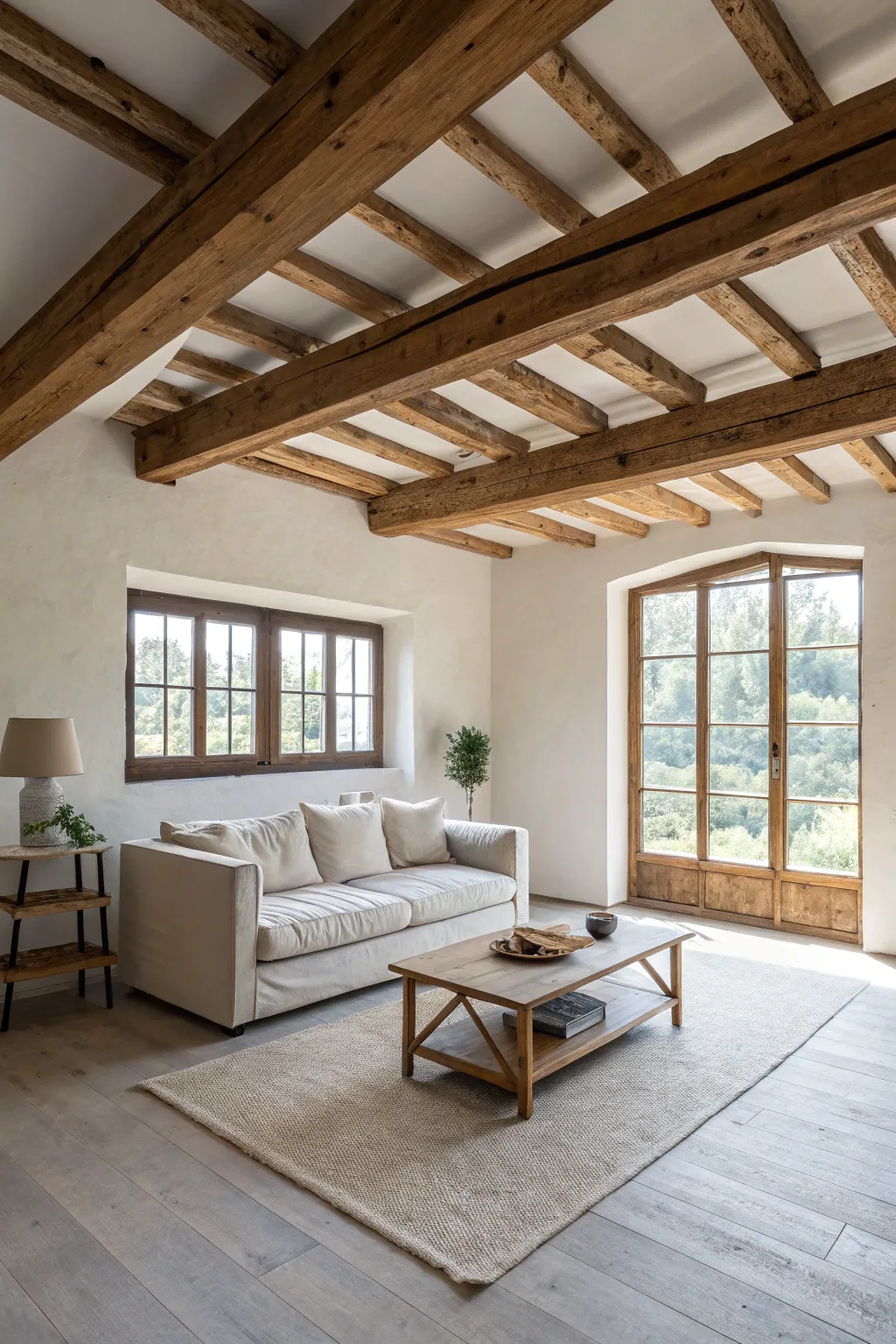There’s something undeniably calming about walking into a space where every element feels intentional, uncluttered, and peaceful. When it comes to the minimalist living room, less really can be more—but only if each choice is infused with care and a personal touch.
Imagine coming home after a long day, sliding off your shoes, and sinking into a lounge that feels like a breath of fresh air. Isn’t that the sanctuary we’re all craving?
Let’s discover some fresh ways to curate your own haven of simplicity.
1. Whispers on the Wall: Understated Artistry for Every Minimalist
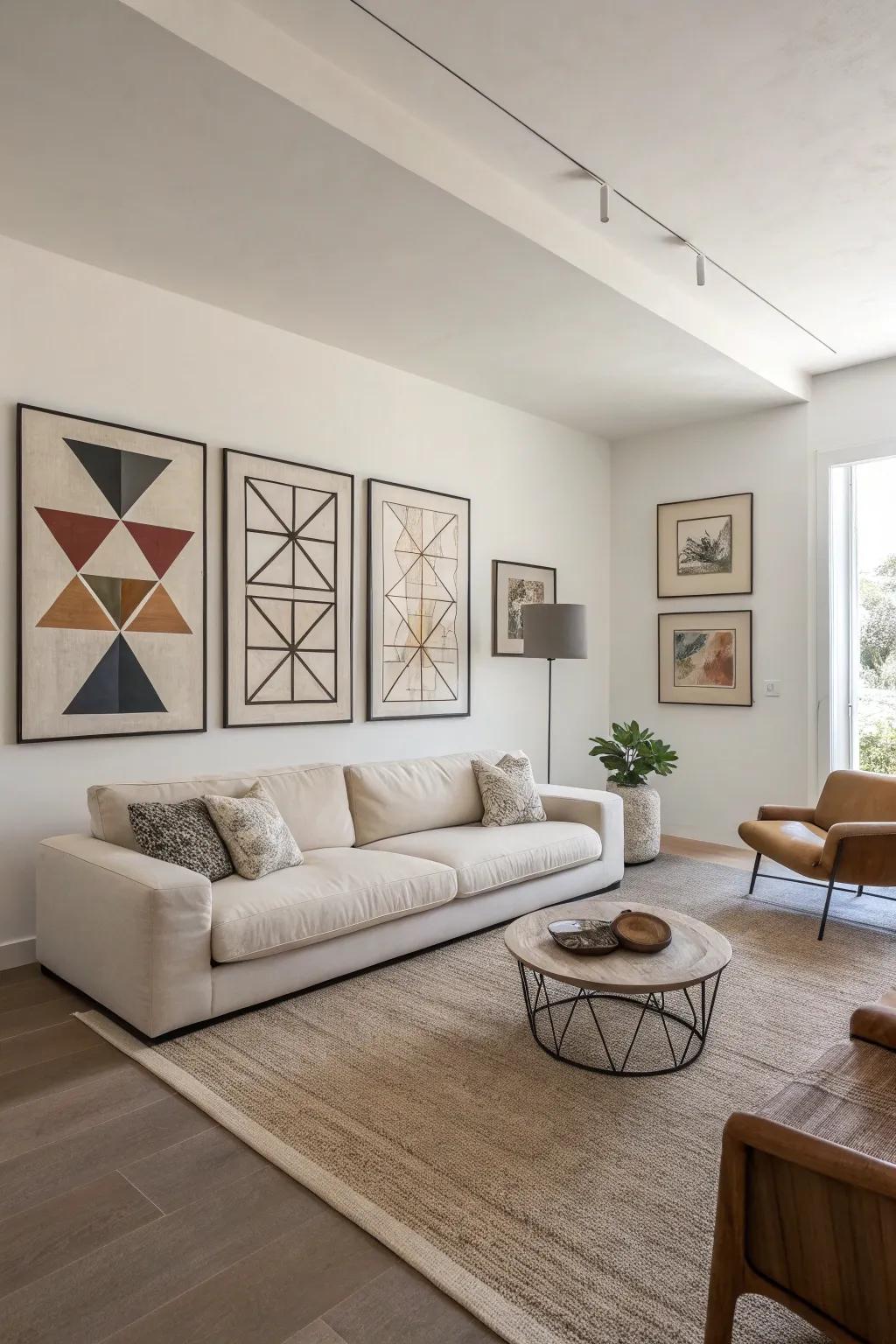
Minimalist living rooms sing when the artwork is intentional, not overwhelming. I often ask my clients, “Does this piece breathe or crowd the wall?” Geometry, a gentle monochromatic photograph, or an abstract brushstroke can all tell a story without shouting over your space.
What does your wall say about you?
Maybe worth checking out:
2. A Subtle Symphony: Playing with Texture in Minimalism
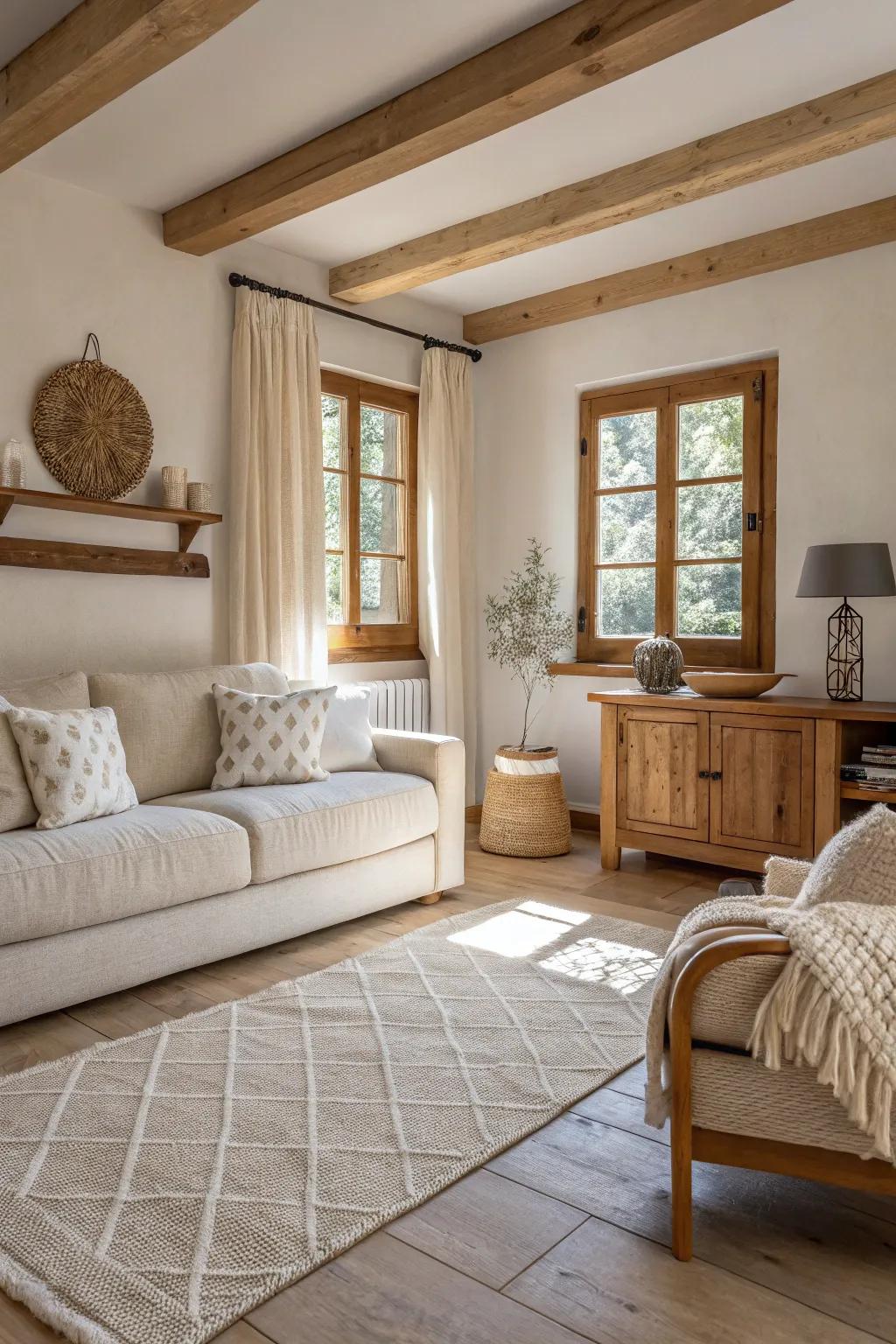
Minimalism shines brightest when you use texture to add depth and warmth. Think beyond what the eye sees—how does your space feel? To keep things lively and layered, mix and match textural elements. I love to start with an easy checklist:
- Layer a chunky knit throw over a smooth linen sofa.
- Anchor the room with a natural fiber rug.
- Introduce tactile wall art, like carved wood or woven hangings.
- Mix matte and glossy finishes for visual contrast.
Texture invites touch and curiosity. A client, Marissa, once said after we finished styling her living room, “I never realized how much a jute rug and knit blanket would make me want to curl up with a book!” Little things make all the difference. Try combining materials you wouldn’t expect—your minimalist room will thank you.
Items that may come in handy:
3. How Much Boldness Is Just Enough?
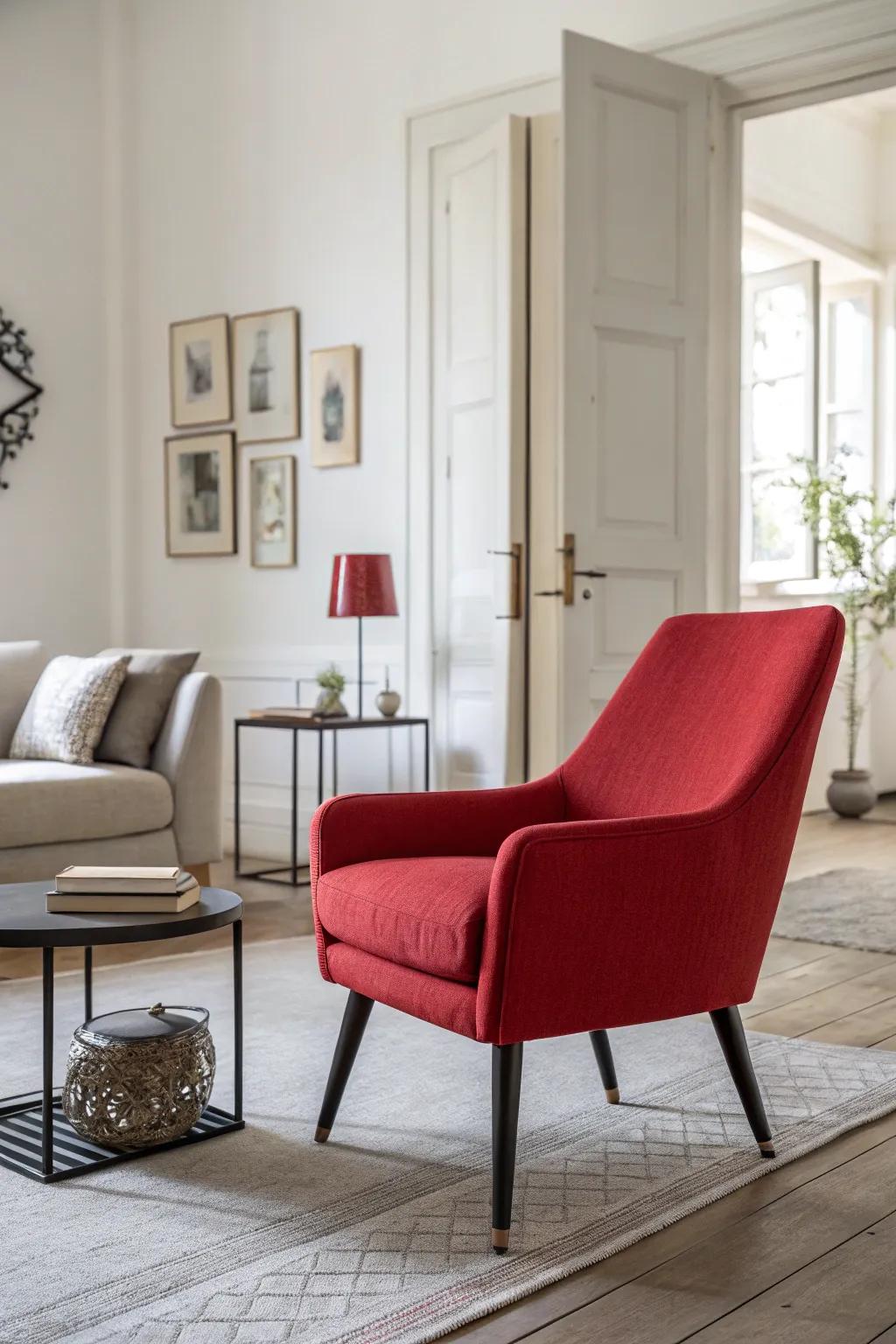
Minimalism doesn’t mean monotone walls and forgotten corners. Sometimes, a single bold accent is all you need to create a spark of personality. I love inviting clients to push their comfort zone just a little—it’s amazing how one pop of color or unique shape can utterly transform the mood of a room.
- Vibrant accent chair: A statement piece in a single eye-catching color.
- Color-drenched artwork: Abstract or figurative, it can set the entire tone.
- Bright, sculptural lamp: Both practical and striking, with a silhouette that stands out.
Isn’t it funny how one unexpected element can change the whole conversation? Recently, I helped Nina—an engineer with a love of symmetry—choose a sunlit yellow chair for her cool-gray living room. At first, she was hesitant. But the moment it arrived, her face lit up. She said, “It’s like the room finally exhaled.”
Dare to let your space surprise you.
When you play with boldness thoughtfully, you honor the bones of minimalism while giving your room the wink of joy it deserves. One brave move is often all it takes to keep things fresh and beautifully balanced.
Consider these options:
4. Why Not Welcome a Bit of Nature?
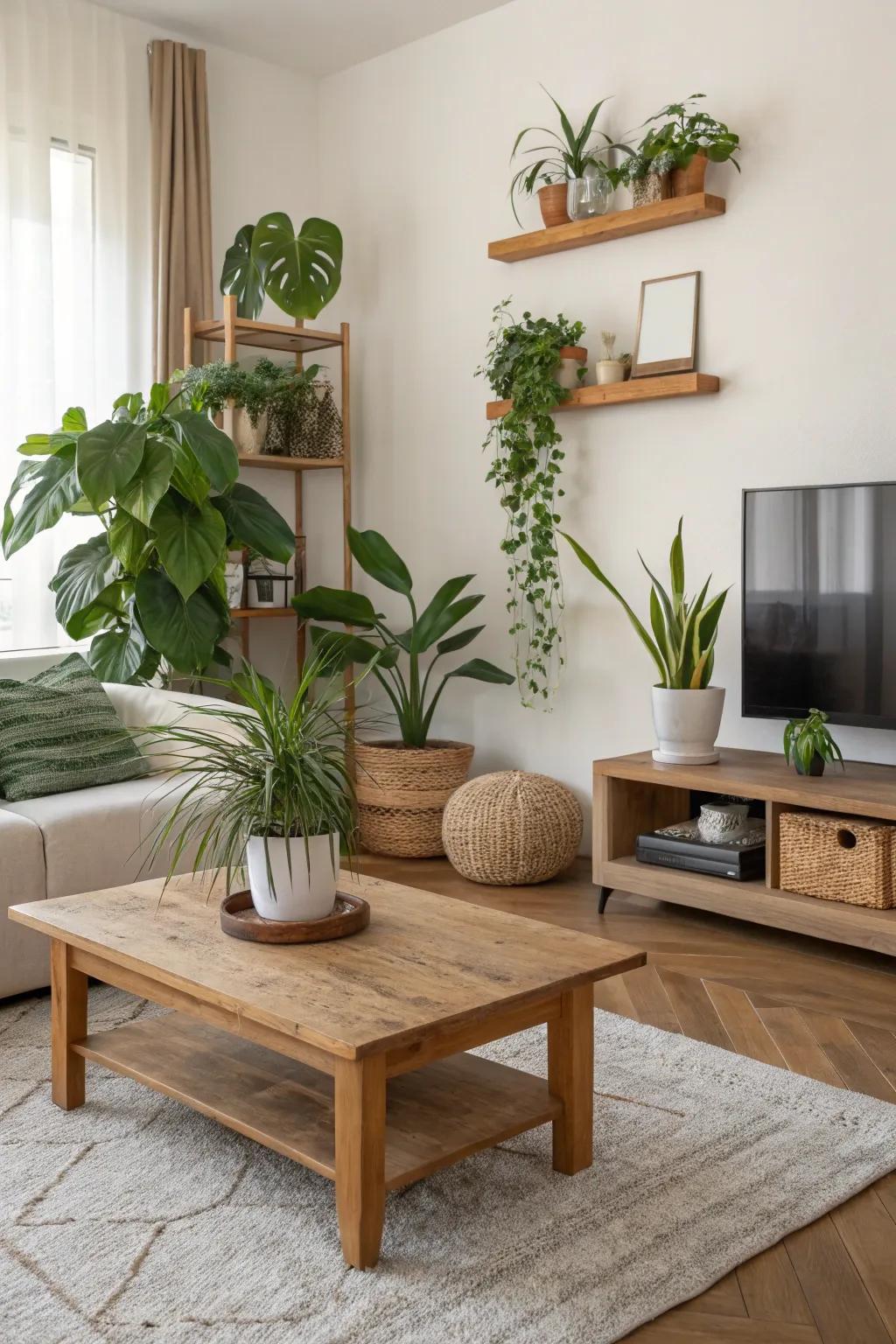
Adding greenery can completely transform a minimalist living room. Plants soften lines, add a dash of color, and bring a sense of calm, all without cluttering the space. Even a single leafy beauty on a windowsill can change the mood—why not give it a try?
Explore these options:
5. Intentional Choices
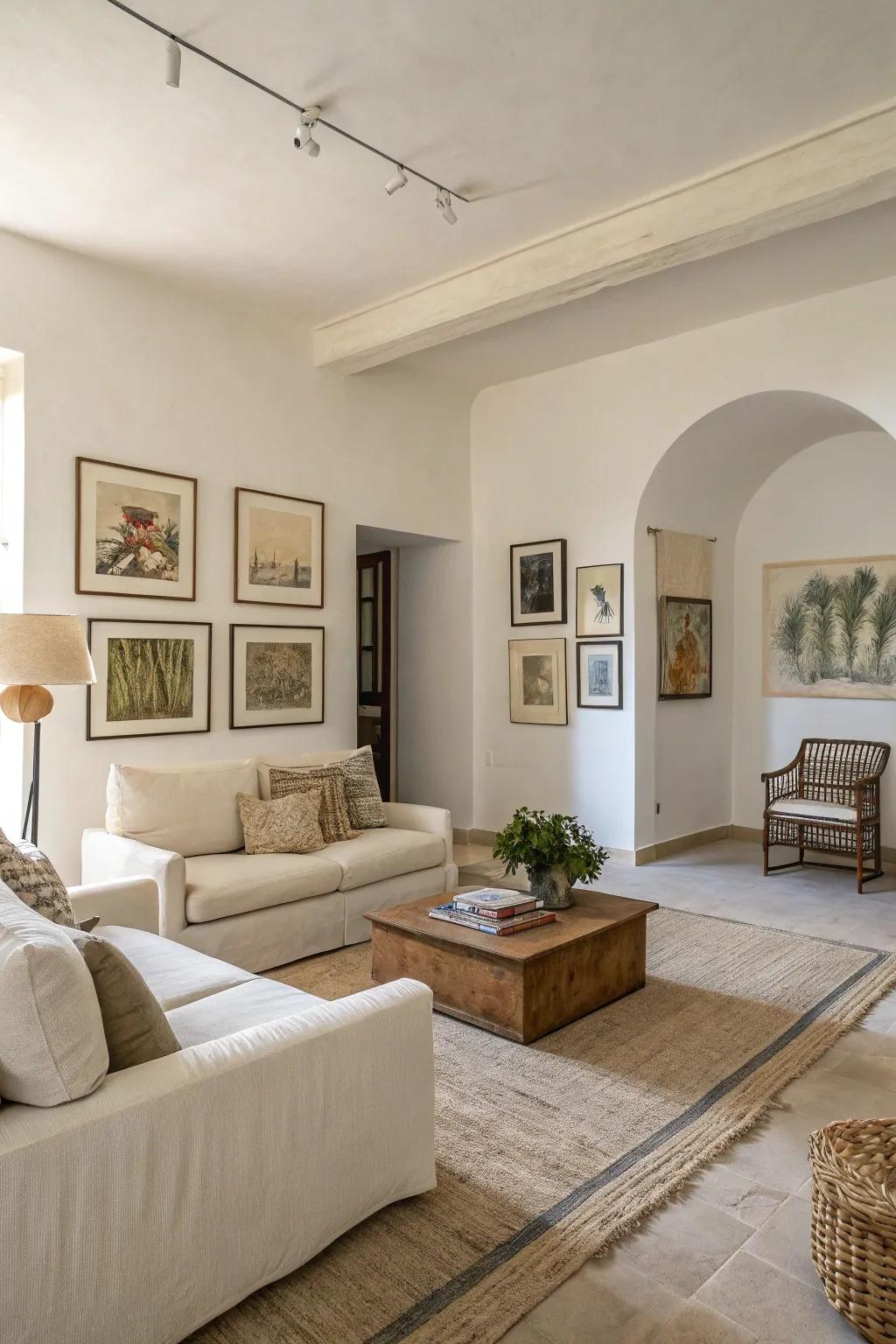
Minimalist décor is all about restraint—but not about giving up personality. I always tell clients that every piece in a minimalist living room should have a reason to be there.
Choose one or two meaningful accents rather than filling the space. Let each item you select speak quietly but confidently. Less noise, more meaning.
Check if these fit your needs:
6. Why Let Glass Steal the Show?
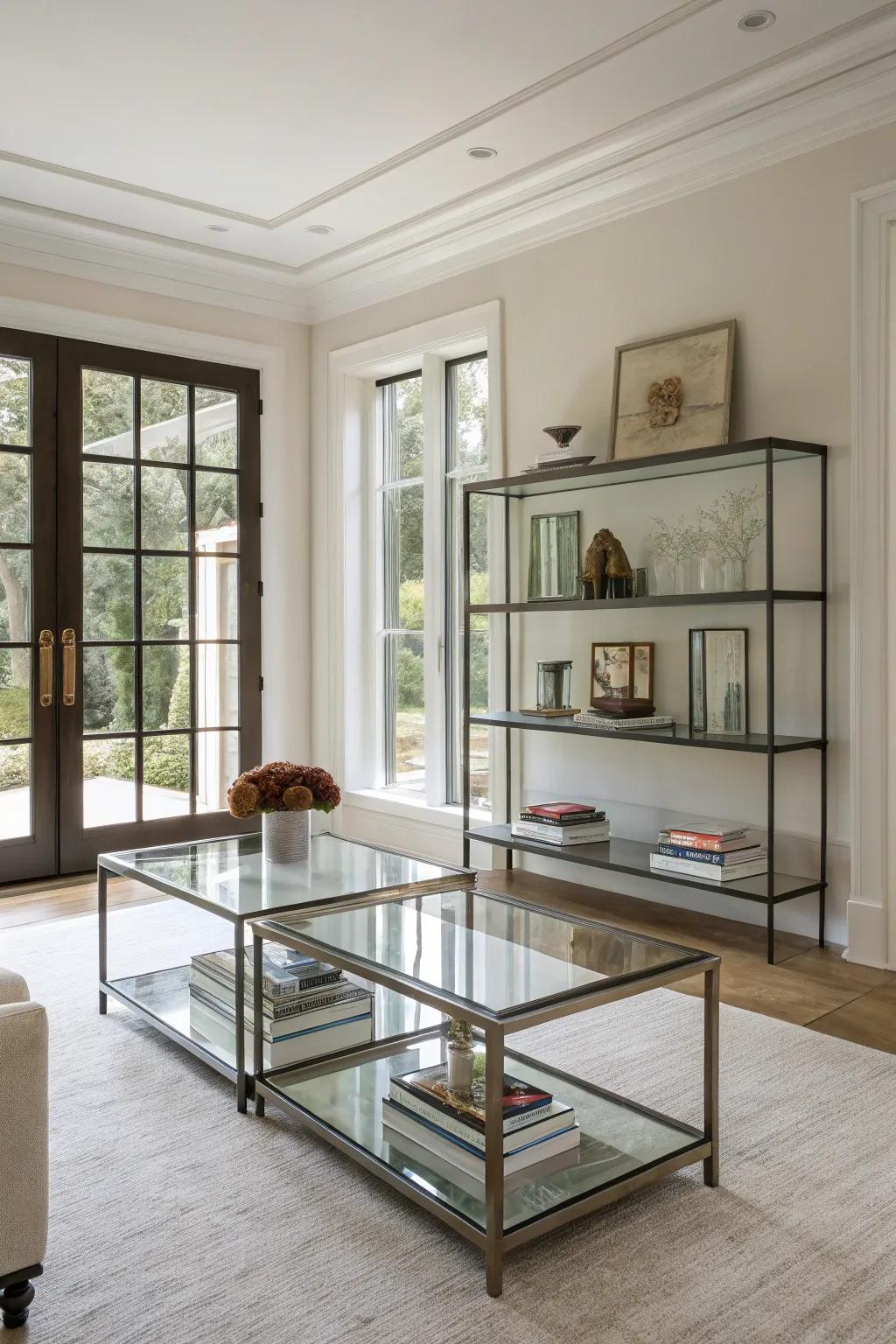
I always say that a little glass goes a long way. Glass tables and shelves are a minimalist’s secret weapon—they invite natural light to dance around the room, making even a small living area feel wide open.
Try introducing a glass feature and watch your space instantly appear lighter and brighter.
Doesn’t everything just look better with a touch of transparency?
Products that could assist:
7. Open Spaces: Let Your Room Breathe
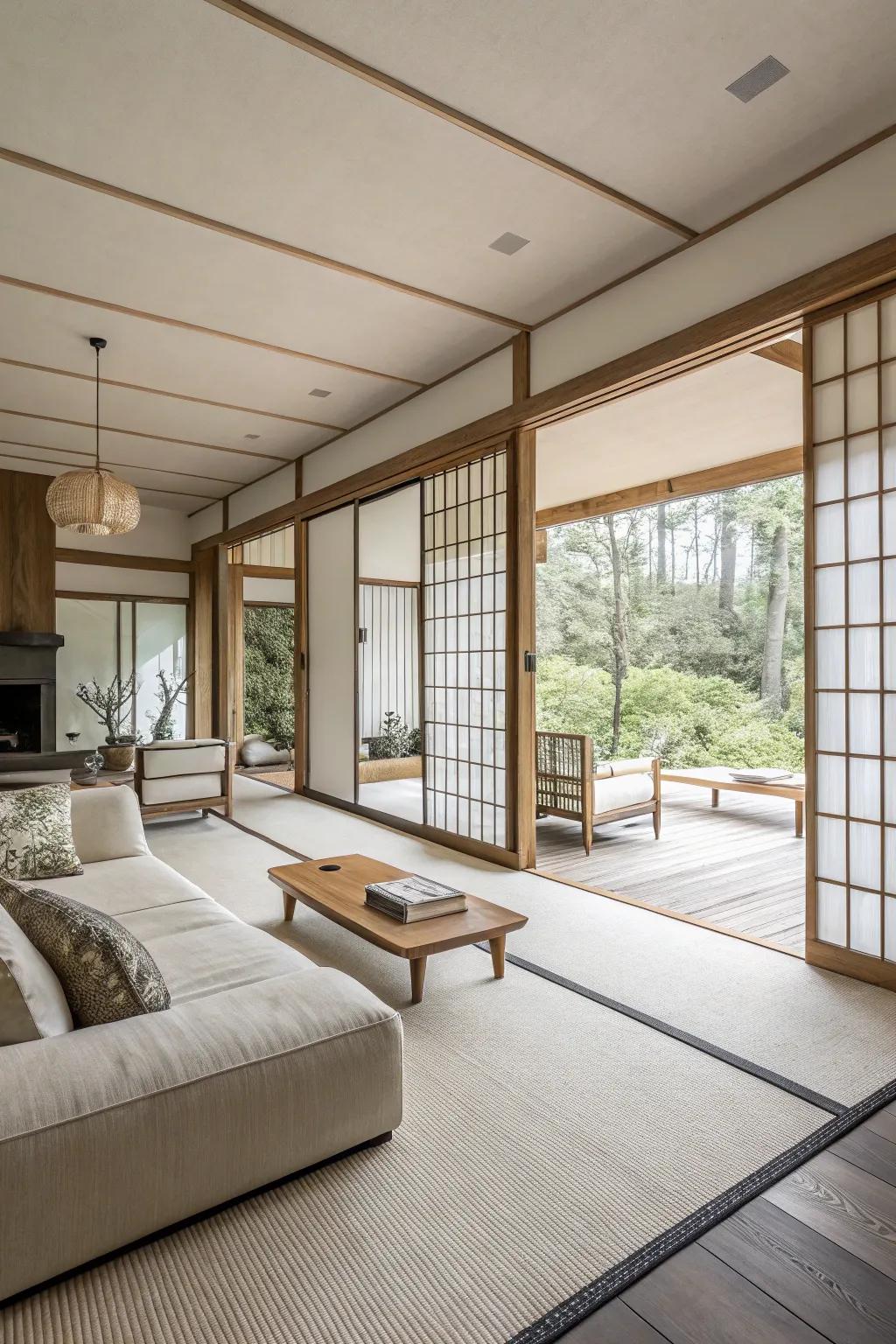
Minimalism doesn’t mean empty—it means intentional. A living room truly comes alive when you let open spaces guide your design.
I once worked with a wonderful client, Julian, who wanted his small apartment to feel more expansive. Instead of crowding his space with partitions and oversized furniture, we focused on creating visual continuity. We removed bulky dividers and chose pieces that sat low to the ground, inviting natural light to sweep through unimpeded. As soon as the excess barriers were gone, Julian was amazed at how the room felt double the size—more like a tranquil retreat than a cramped living space.
Have you ever noticed how a clear line of sight makes a room instantly more inviting? It’s all about making the most of what you have. To open up your living room, try these practical approaches:
- Arrange furniture to direct flow, not block it.
- Use light, moveable pieces that can be shifted as needed.
- Limit tall shelves and cabinets to keep walls visually clear.
When in doubt, leave a little more space than you think you need. That extra room is an invitation—to breathe, move, and feel at ease.
A few things you might like:
8. Elevate with Wood
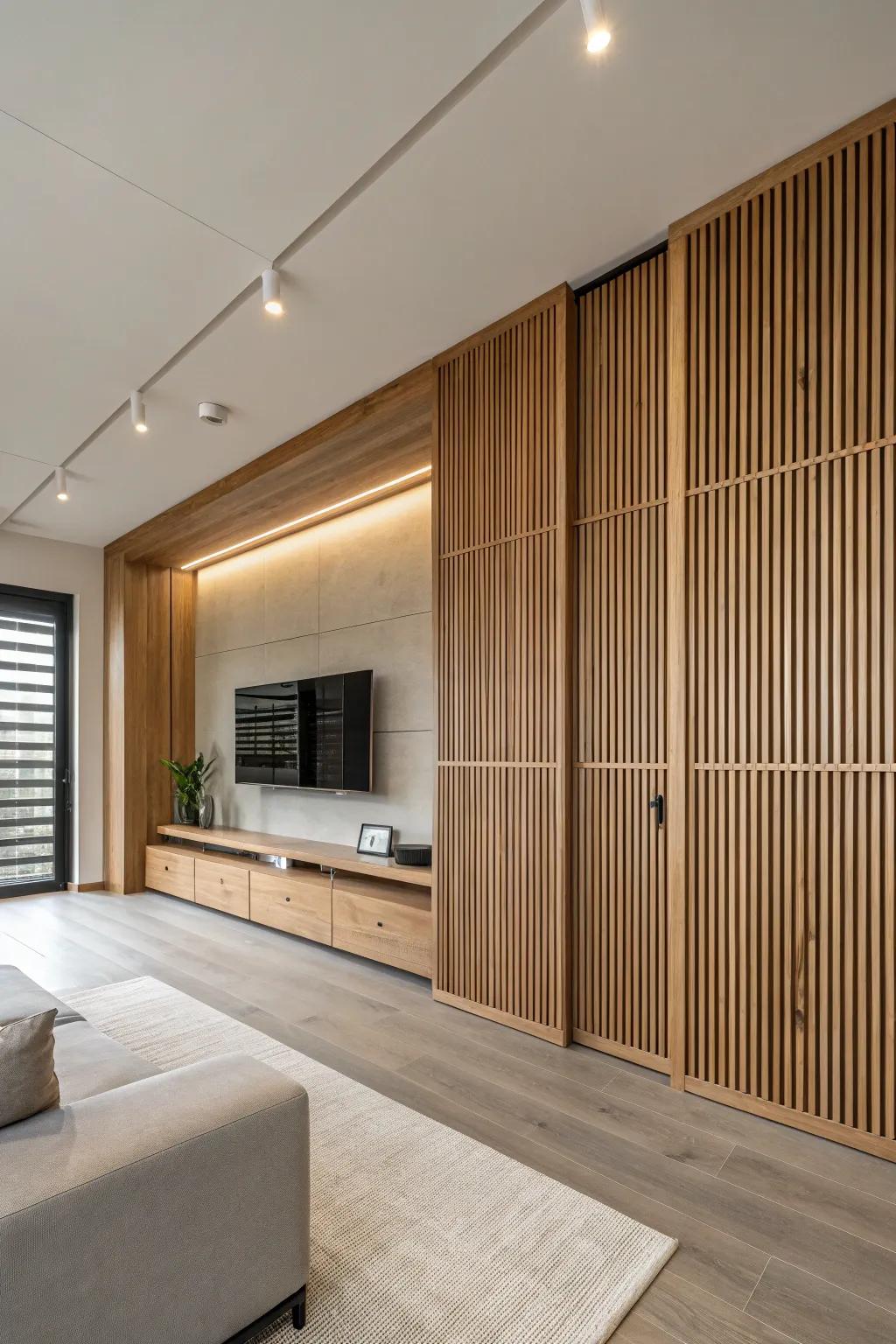
If you want a minimalist room that feels refined yet inviting, try incorporating wood slat panels. They’re not just for looks—these slender lines bring rhythm and gentle definition to open spaces, making every inch feel intentional.
Some handy options:
9. Anchoring the Room: The Power of a Focal Point
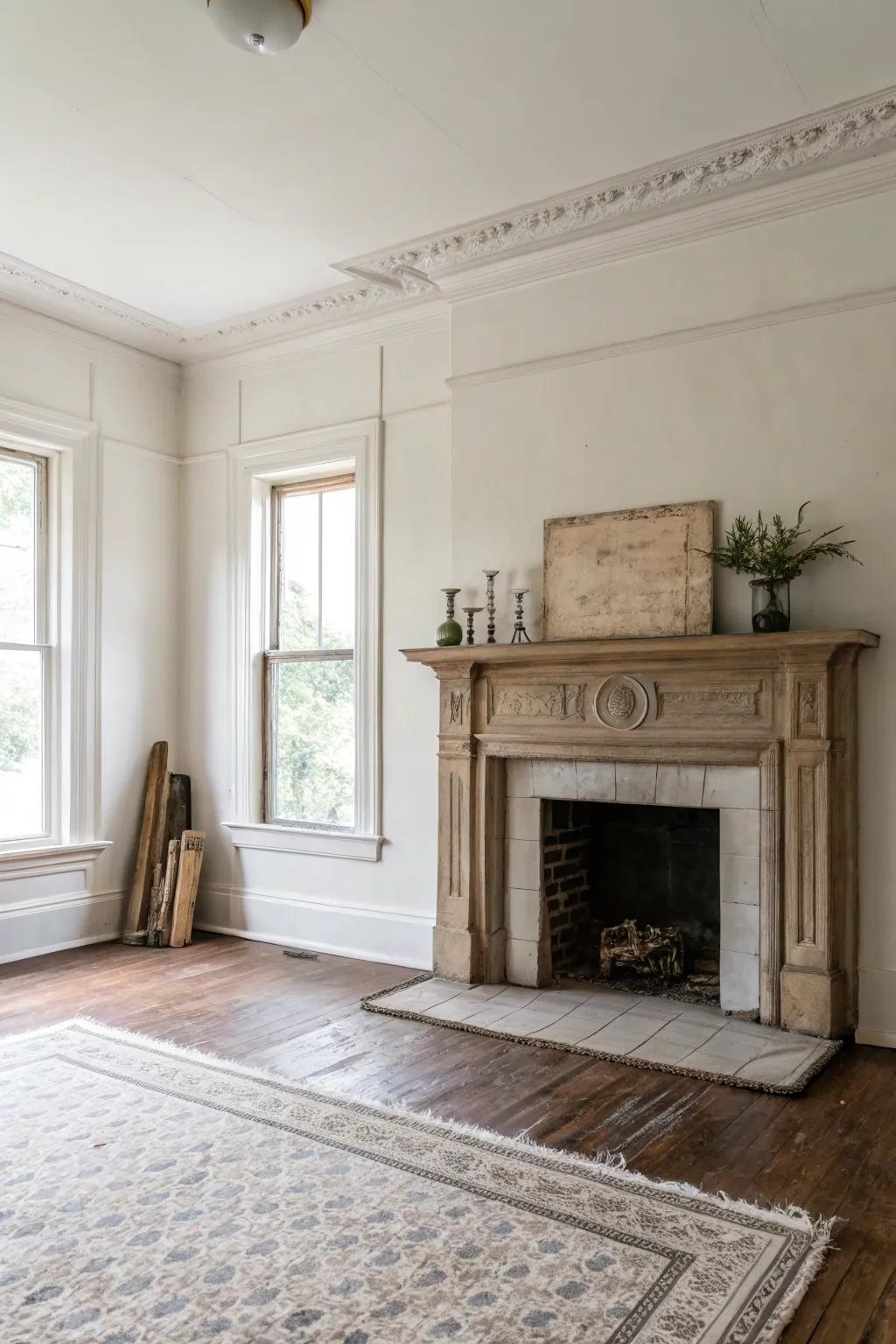
Every room needs a heartbeat—a place the eye can rest and the mind can wander. Creating a focal point anchors the room, whether you choose a bold mirror, a striking mantle, or a single piece of sculptural art. These pieces set the tone for everything else in your minimalist space.
I remember when I worked with the Thompsons. They longed for simplicity, yet wanted their living room to feel personal. We centered their room around an oversized mirror with a brushed metal frame—suddenly, the whole space felt curated and complete.
Minimalist design is never empty; it’s intentional.
May just do the trick:
10. Illuminate Everything!
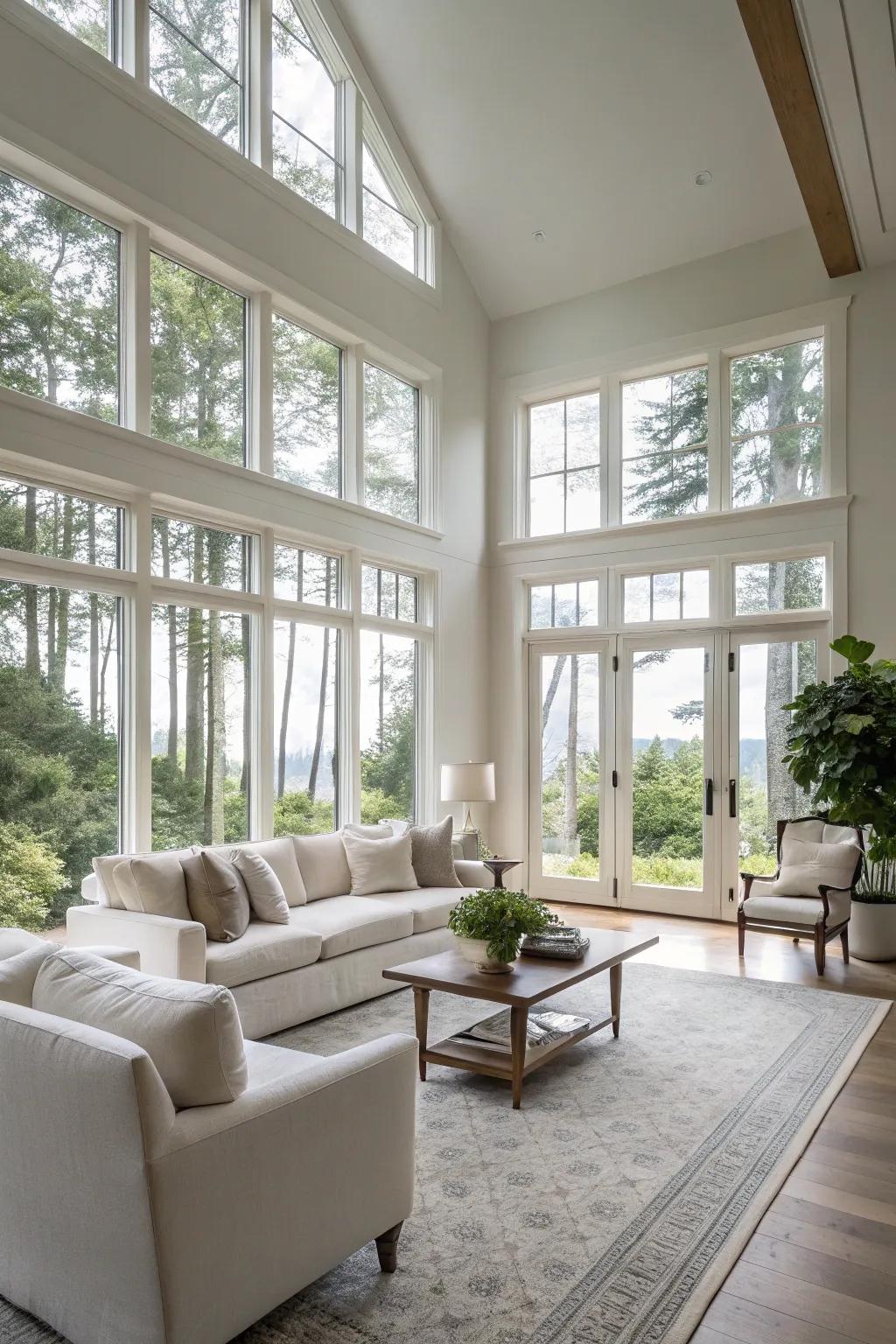
There’s nothing like the gentle flood of sunlight through open windows to make a living room come alive. In minimalist spaces, natural light isn’t just a bonus—it’s the secret ingredient that makes every detail shine.
If you want to chase away shadows and highlight your favorite features, start by considering these strategies:
- Hang airy, translucent curtains to enhance the soft quality of daylight.
- Position mirrors across from windows to bounce light around the room.
When I work with clients craving openness, my mantra is always: let the light in! Imagine how different your evenings could feel with the sunset painting your walls. Are you making the most of every golden hour in your living room?
These products might be useful:
11. Monochrome Magic: Make Your Living Room a Calm, Cohesive Retreat
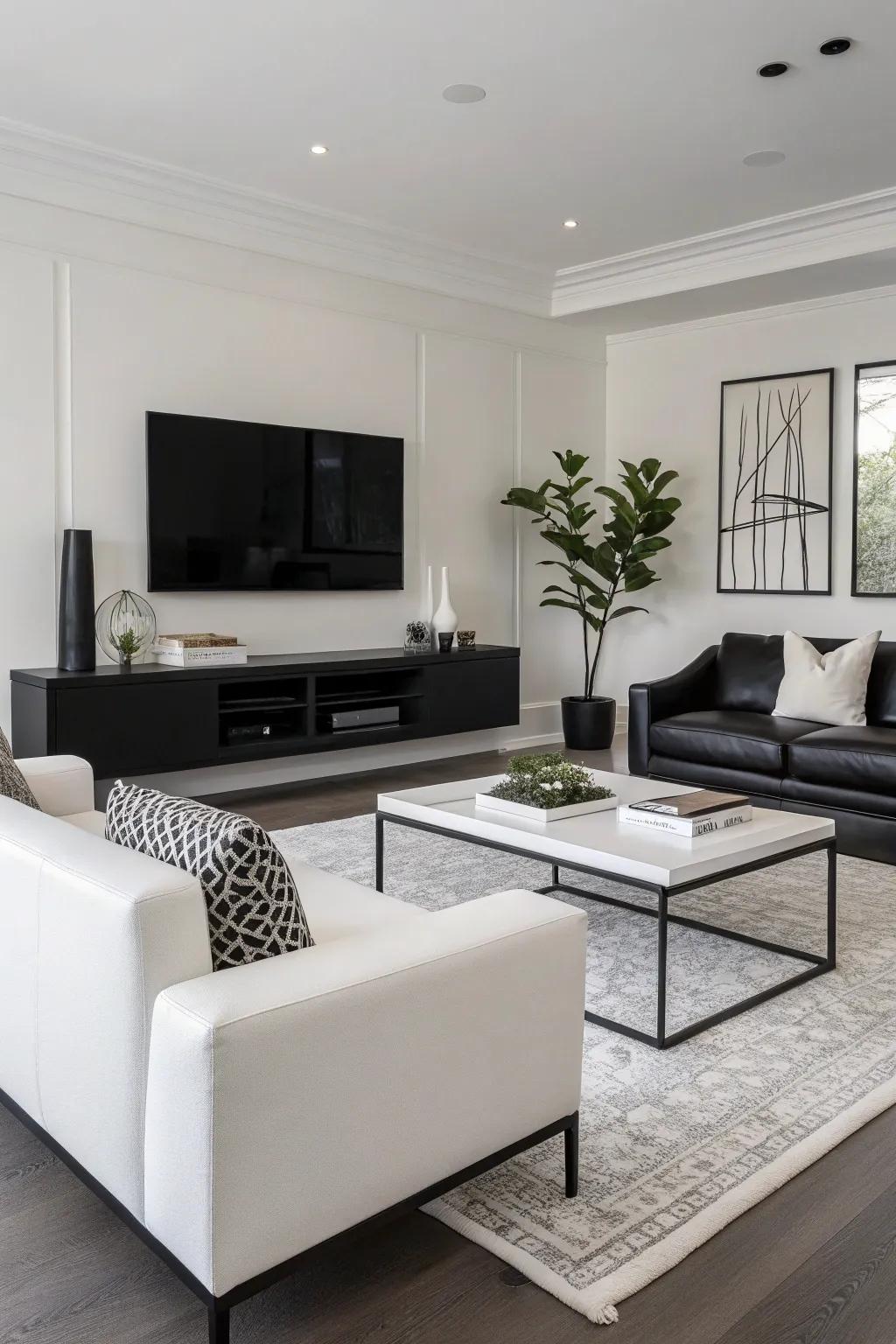
A monochrome scheme isn’t just a safe bet for minimalist style—it’s an open invitation to create a visually striking, deeply calming haven. When you pare back your palette to different shades of a single color (think blacks, whites, or endless greys), your living room suddenly feels more intentional, curated, and—dare I say—serene.
Sometimes the simplest colors whisper the loudest.
But here’s the trick: embracing monochrome does not mean embracing monotony. The secret sauce is all about layering—choosing varied materials, gentle patterns, and subtle contrasts that keep the eye softly moving. Instead of clashing hues vying for attention, your new minimalist space offers gentle visual flow from wall to sofa to floor.
One of my clients, Mia, was sure that an all-grey palette would leave her space feeling cold. But as we balanced her slate sofa with creamy throws and a touch of matte-black ceramics, the room took on a whole new depth. The textures—smooth, nubby, sleek—invited touch and made the space feel anything but one-note.
If you’re curious how to get started, here are three ways to make your monochrome living room look intentional, not accidental:
- Vary your texture—from chunky knits to slick glass, the mix keeps monochrome lively.
- Introduce subtle patterns like herringbone or graphic stripes (even a gentle marbling works wonders).
- Sprinkle in a few lush plants or natural wood accents to keep things from feeling too stark.
Isn’t it lovely to think that a single color can offer so much variety? Try living with less hue and more soul—the result is often a space that feels like a deep breath at the end of a long day.
A few suggestions:
12. Two-Tone Walls: Subtle Drama Without Clutter!
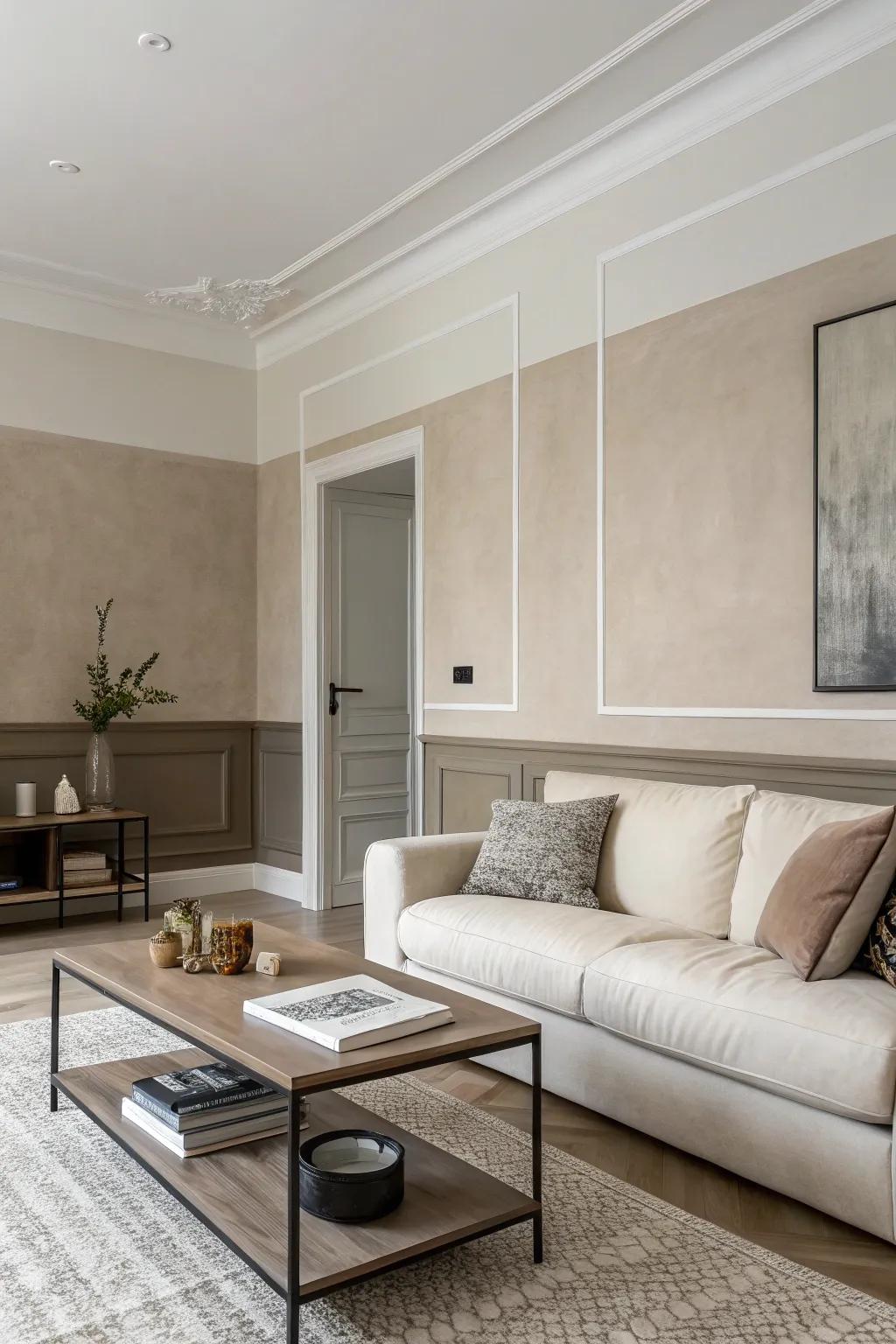
Minimalist design doesn’t have to mean monotone walls. In fact, adding a second subtle shade can make a world of difference! I love showing clients how a gentle shift in color can create visual texture without introducing chaos. Forget busy patterns; think gentle shifts that draw in the eye.
The magic of two-tone walls lies in their ability to add depth and dimension—especially when you mix soft neutrals like dove grey with warm alabaster, or creamy ecru contrasted with a grounding taupe. If you have architectural details like moldings or picture rails, use them! Let your colors play off these features for a composed yet captivating effect. Painters and designers often use terms like color blocking and tonal gradients—don’t be intimidated by the lingo. The end goal is to guide the eye without overwhelming it.
If you’re ready to try this transformative (yet minimalist!) technique, here’s how I guide clients through the process step by step:
- Choose two complementary neutral shades. Test them on your wall to see how they shift with the light throughout the day.
- Mark your boundary line clearly using painter’s tape—whether you’re going for a horizon effect, a vertical split, or accenting a specific feature.
- Paint your lighter shade first, let it dry fully, then carefully fill in the second color.
- Remove tape before the paint fully dries for a crisp, satisfying edge!
One of my favorite projects was with Sarah, a mother of three who wanted her reading nook to feel special, serene, but not busy. We chose a pale sand for the upper wall, then grounded it with a gentle ash tone below. Sarah told me it was like having a soft embrace every time she sat down with a book.
Minimalism is all about intention—and sometimes, just a hint of color can tip the scales toward beautiful.
Some ideas to consider:
13. Making the Most of Every Inch: Functional Pieces for Minimalist Spaces
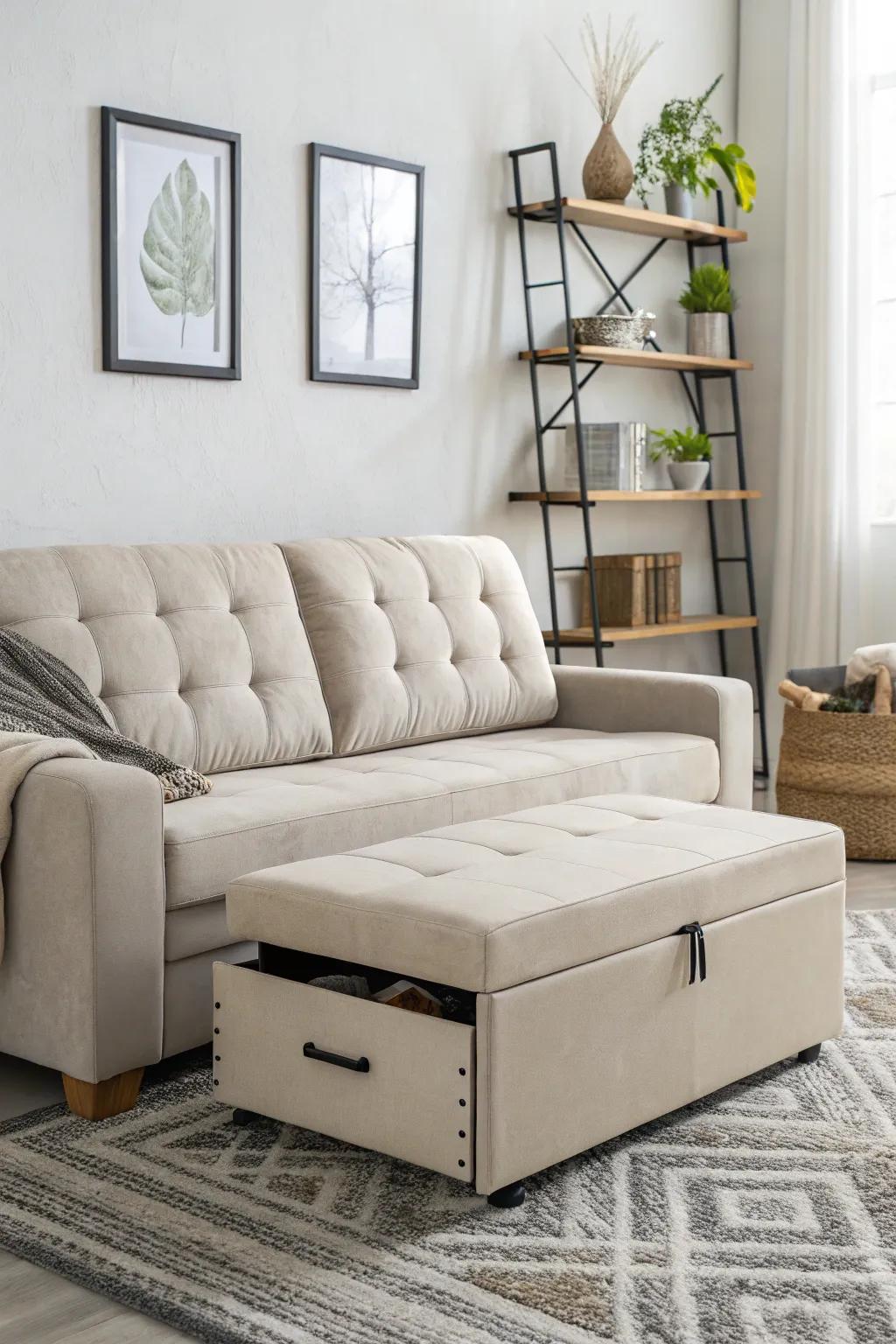
One of my most memorable projects was with the Thompsons—a couple downsizing from a busy family home to a city apartment. They wanted a fresh start, with just enough to meet their needs and nothing more. We tackled it with a single guiding principle: everything deserves a purpose, and preferably, more than one!
Minimalism isn’t about having fewer things, it’s about having more freedom. Clutter-free surfaces invite gatherings, playtime, or a spontaneous dance break. But how do you keep things neat when life is anything but simple? The answer lies in choosing pieces that can do double duty—or even triple.
- Storage ottomans: Tuck away blankets, magazines, and remotes while offering extra seating.
- Convertible sofa beds: Host overnight guests without needing a separate room.
- Nesting tables: Spread them out for movie snacks or stack them to reclaim floor space.
- Modular shelving units: Adapt them over time as your needs evolve.
A little story here: the Thompsons were convinced that going minimal meant giving up their beloved game nights. But when we found a sleek coffee table that also stored all their board games, they realized minimalism could add joy, not subtract it.
Consider this your permission slip to live bigger with less. Let go of the extras—and make room for what truly matters.
You might like:
14. Cozy Layers, Minimal Fuss
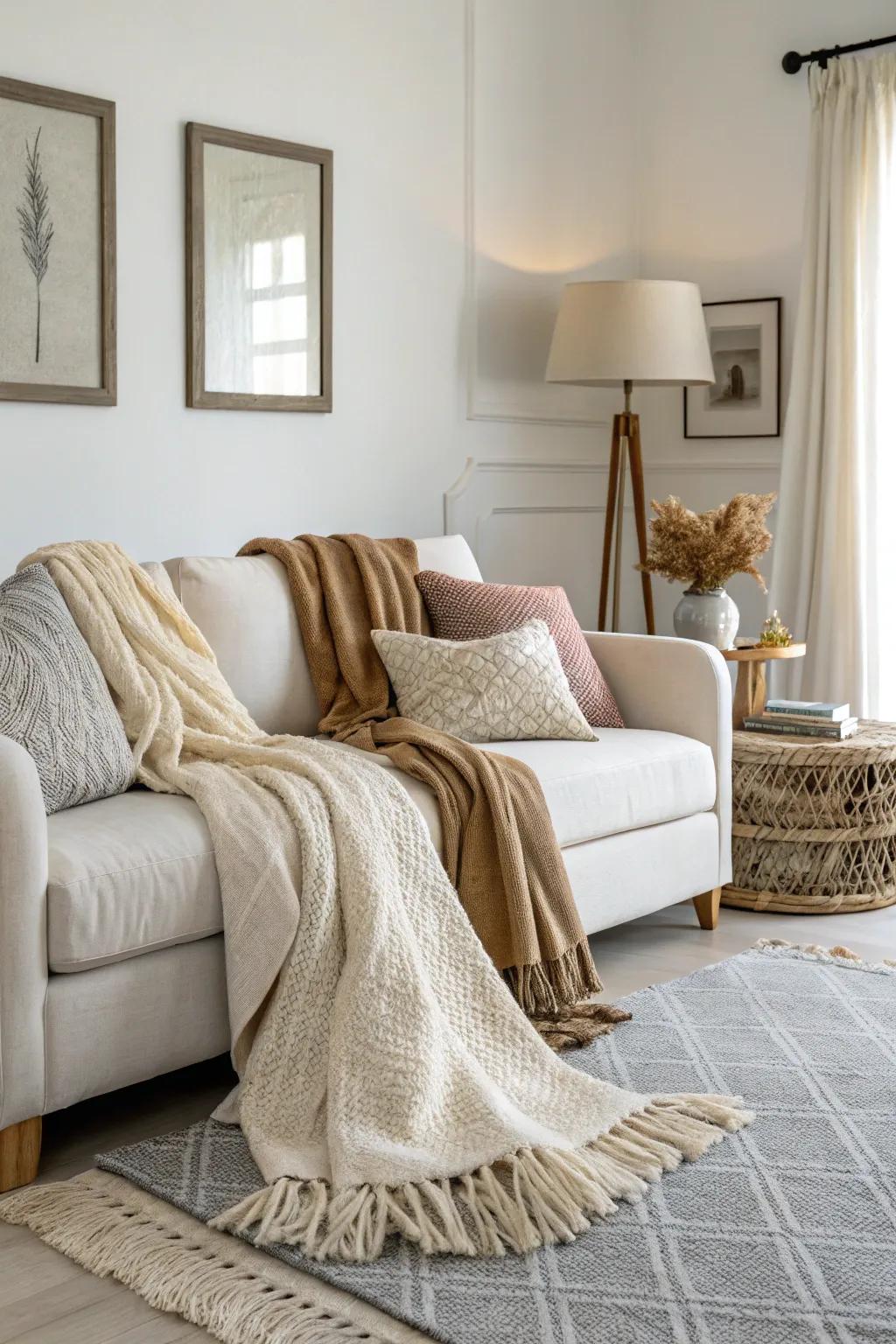
A minimalist living room doesn’t have to feel cold or impersonal—trust me, softness makes all the difference. Once, I helped my clients, the Harrisons, turn their streamlined space into a true “hug in a room” with just a few thoughtful, tactile touches.
It’s remarkable how quickly you can transform the feel of a space by focusing on a few cozy essentials. When you’re working with minimalist bones, every choice stands out:
- Drape a soft knitted throw across your sofa’s armrest for instant warmth and casual elegance.
- Mix in plush pillows with subtle textures or single-color embroidery to add a layer of comfort without overpowering your palette.
- Lay down a textured rug—think boucle, nubby wool, or woven cotton—to ground the space and encourage bare feet.
I remember the Harrisons’ amazement when we swapped out their scratchy old throws for a single, deeply soft blanket; suddenly, their living room became the favorite family hangout on chilly evenings.
Sometimes, it’s those little things that make you want to linger just a bit longer.
You might give these a try:
15. Why Do Clean Lines Transform a Space?
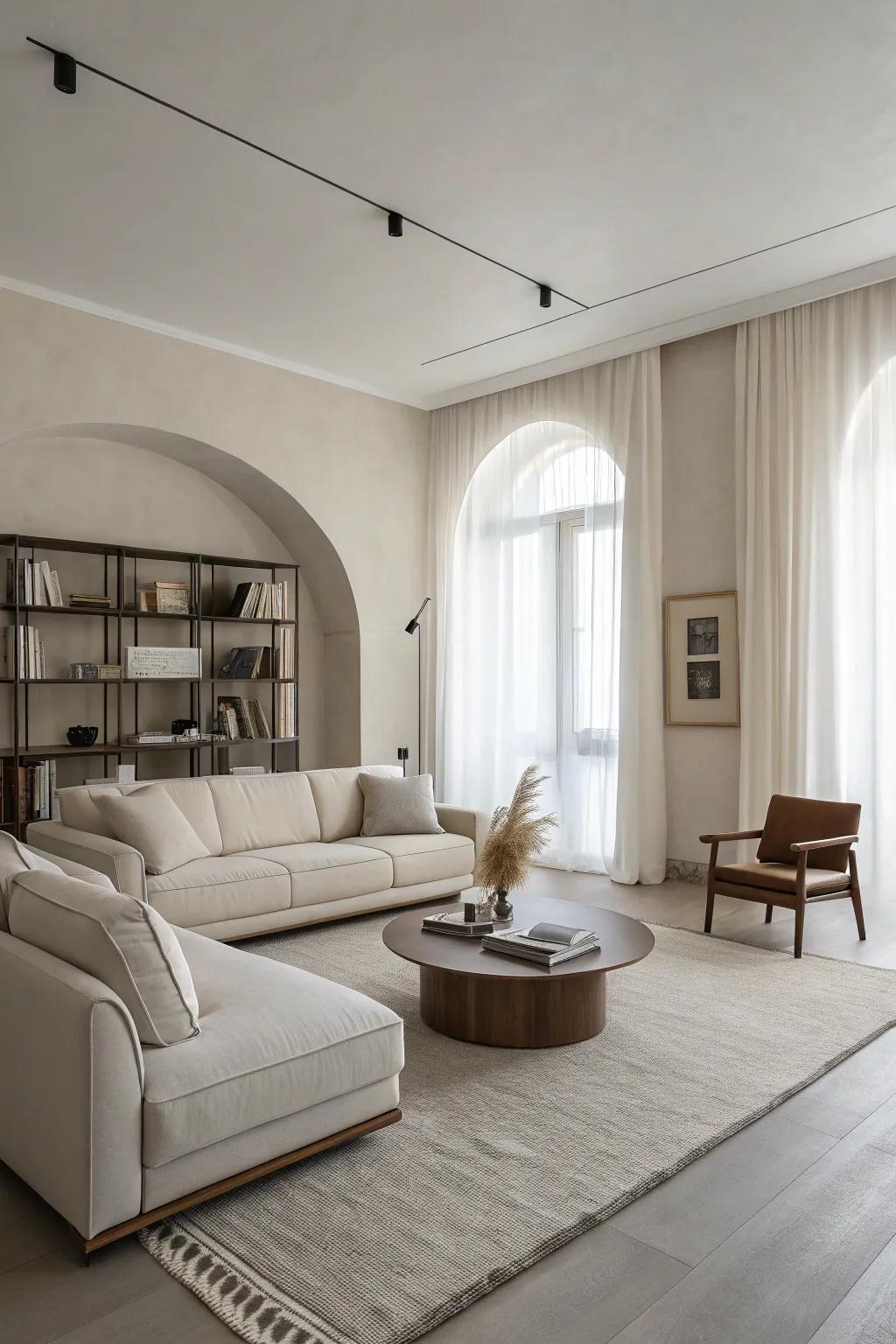
Have you ever noticed how a room with clean lines seems to exhale? Sharp edges and gentle curves bring clarity, giving your eyes and mind a place to rest. That’s the magic of minimalism—spaces can speak without shouting.
When I advise clients on selecting furniture, I encourage thinking about more than aesthetics. How does a piece feel? Does it create harmony with the rest of the room? Here are a few guiding tips I share:
- Choose furniture with a low profile to keep sightlines open.
- Seek out pieces with slender, unembellished legs for a weightless effect.
- Favor subtle curves over ornate decoration to add softness and flow.
A few months ago, Sarah approached me for help redesigning her compact living room. She was juggling remote work, family movie nights, and the occasional yoga session—all in the same space! Together, we picked a sofa with crisp lines and a coffee table with gentle edges. The result? She told me it felt like her room “finally exhaled.”
Simplicity is an invitation—to slow down, to breathe, to be fully present in your own home.
A few helpful options:
16. Soft Surroundings
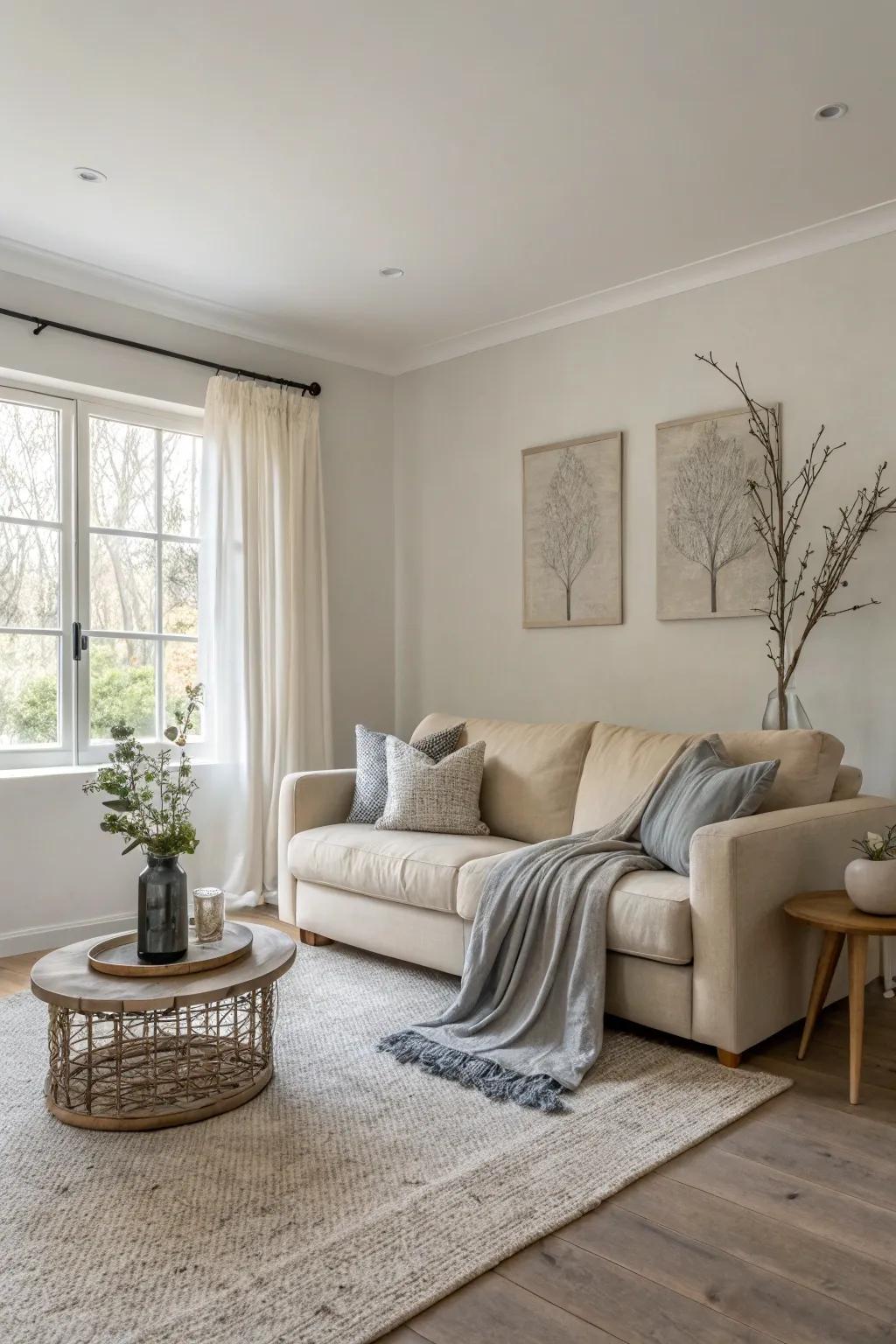
Letting neutral colors take the lead is like setting a soothing background track for your life—they don’t demand attention, but they make every moment feel gentle and grounded.
I once helped Linda and James create their minimalist haven by layering whites, creams, and beiges throughout their living room. The transformation was remarkable—suddenly, the whole space breathed easier.
Embrace the calm; your senses will thank you.
These products might help:
17. Lighting as Art: Shine Bright With Intention
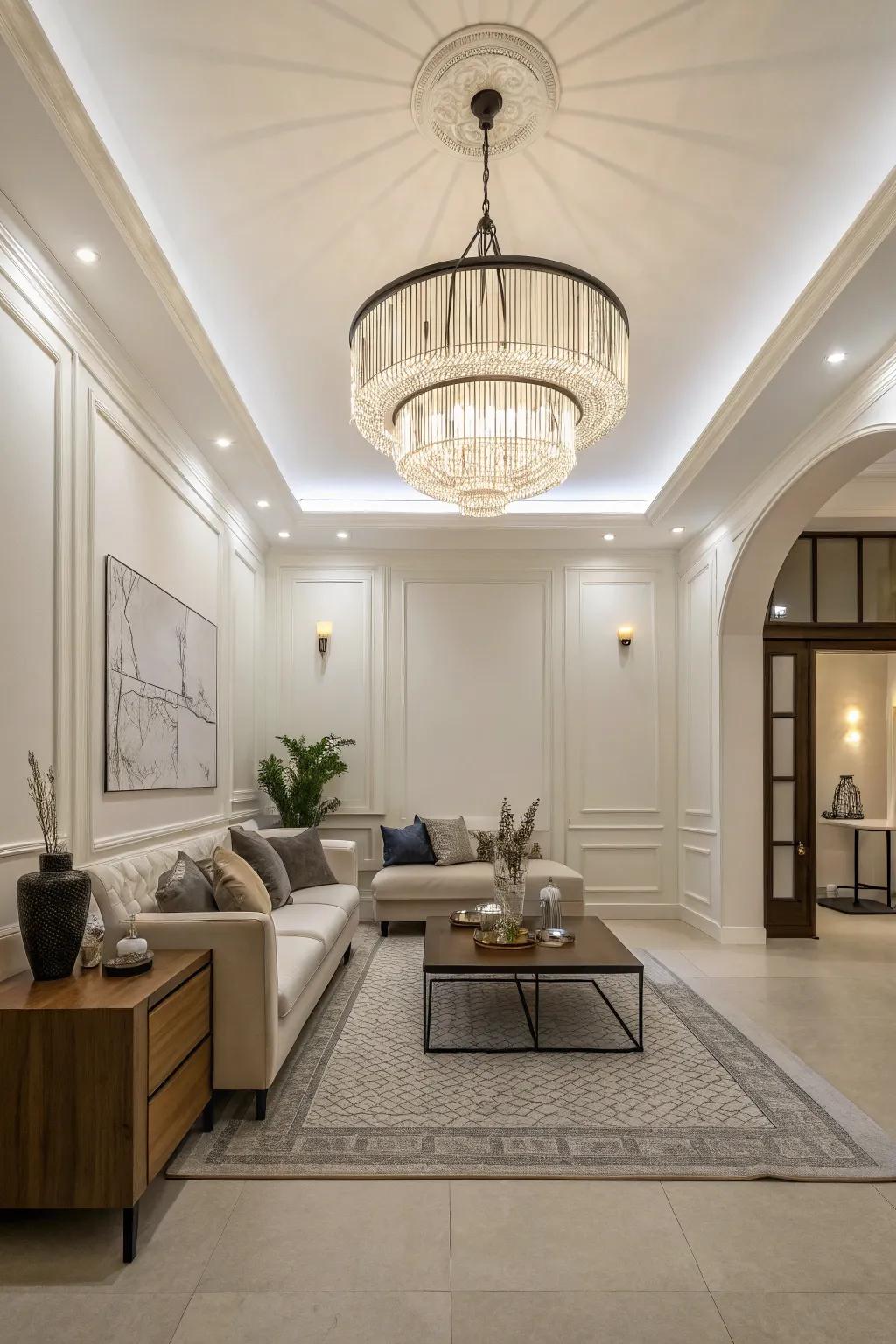
Lighting is so much more than just a way to see your space—it’s the mood-setter, the conversation starter, and, when chosen thoughtfully, the statement piece that brings a minimalist living room to life. When I first stepped into my client Lena’s home, I knew her living room needed a little spark. We found the perfect sculptural pendant that became the highlight of her serene space.
When considering light fixtures, look at them as both tools and treasures. The right choice can do more than illuminate—it can elevate a room’s spirit without adding visual clutter. If you’re not sure where to start, let your eye rest on these practical steps:
- Layer your lighting by combining overhead, task, and accent sources for a balanced look.
- Seek out fixtures with clean lines and natural materials—think brushed brass, pale wood, or opal glass—to echo your minimalist theme.
- Use dimmers or adjustable bulbs to shift the atmosphere as needed. Flexible lighting keeps your options open from sunrise to nightfall.
A thoughtfully-chosen light fixture isn’t just a necessity; it’s an opportunity to let your home shine. If you’re aiming for minimalism, let your light fixtures do double duty—as practical illuminators and as sculptural works of art.
Sometimes, the best way to brighten up a room is to let your light fixtures do the talking.
Check these products out:
18. Incorporate Architectural Elements
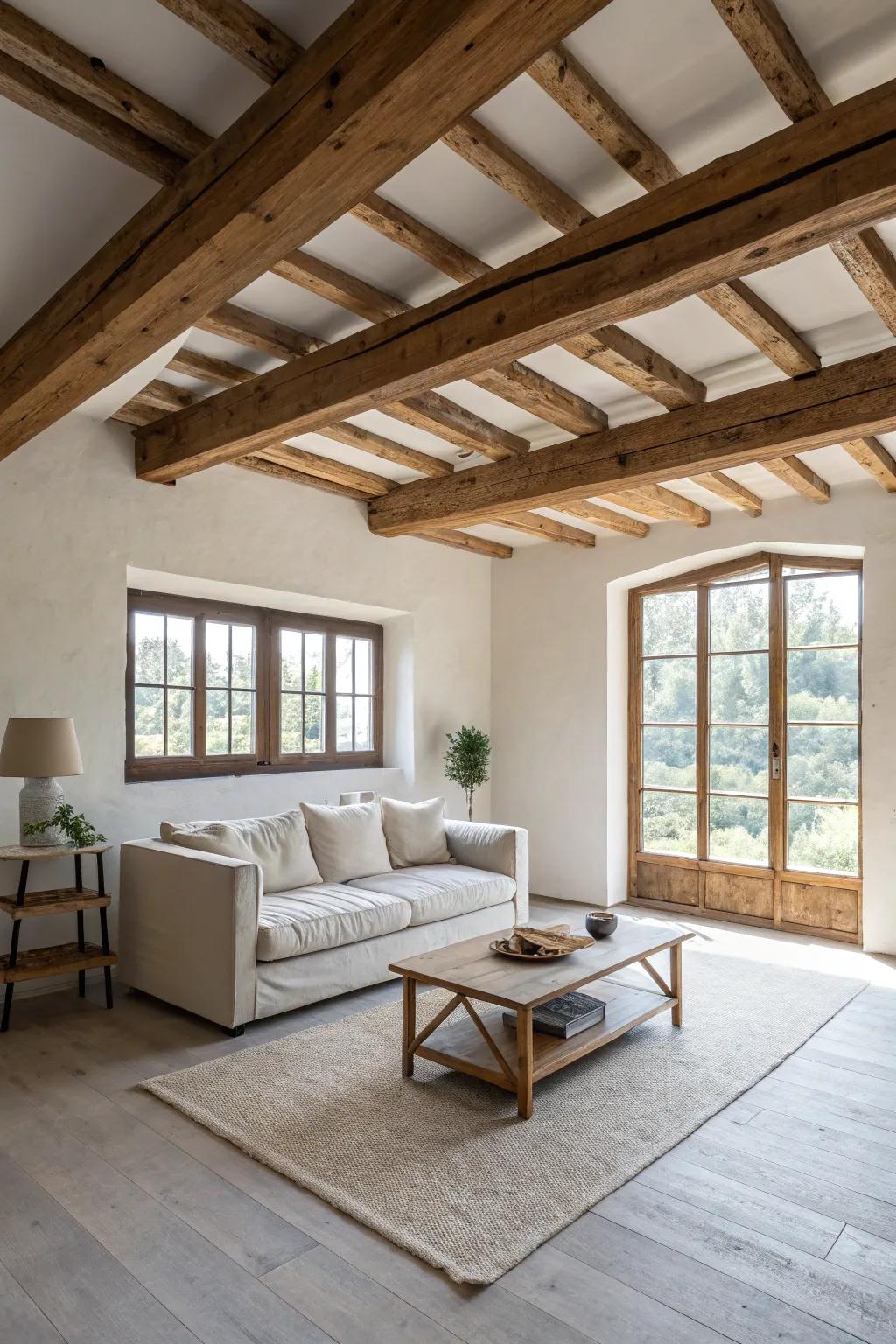
Showcase architectural elements like exposed beams or structural columns. These features add character without overwhelming the minimalist design.

